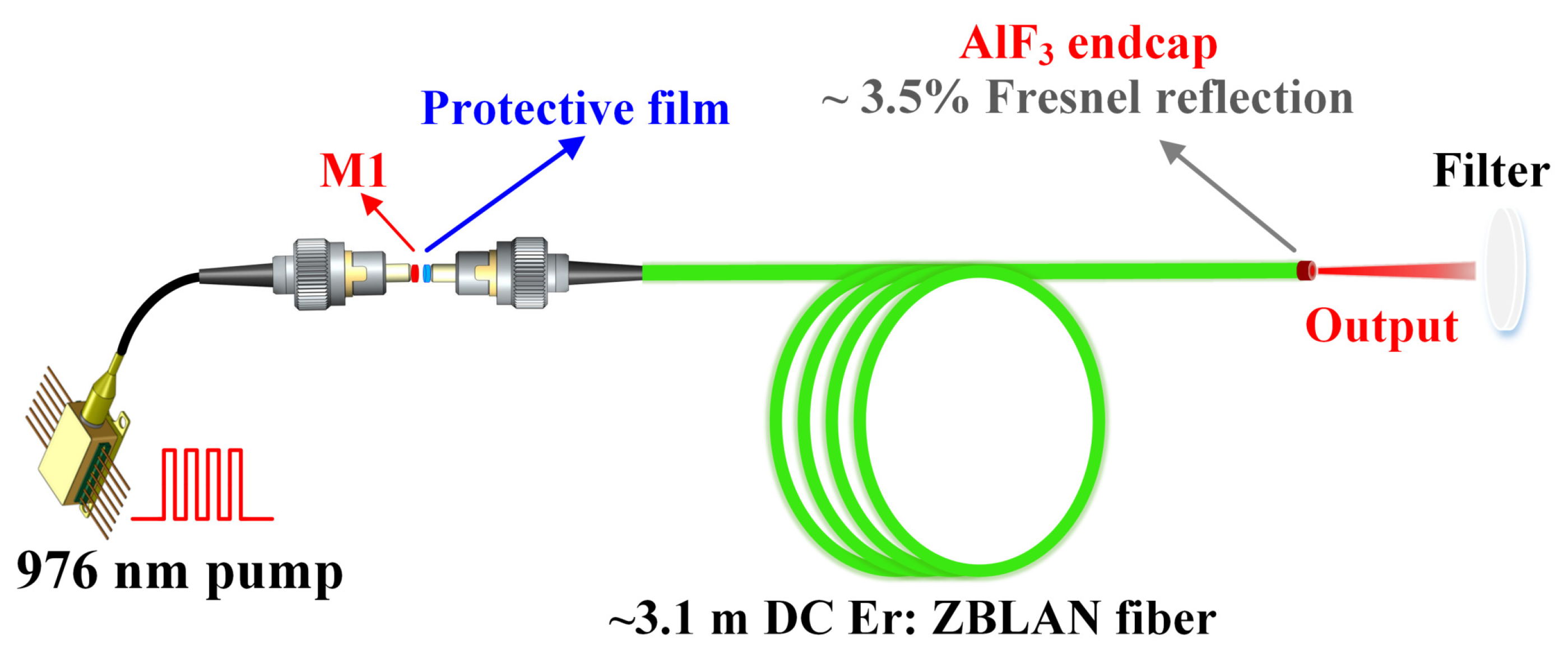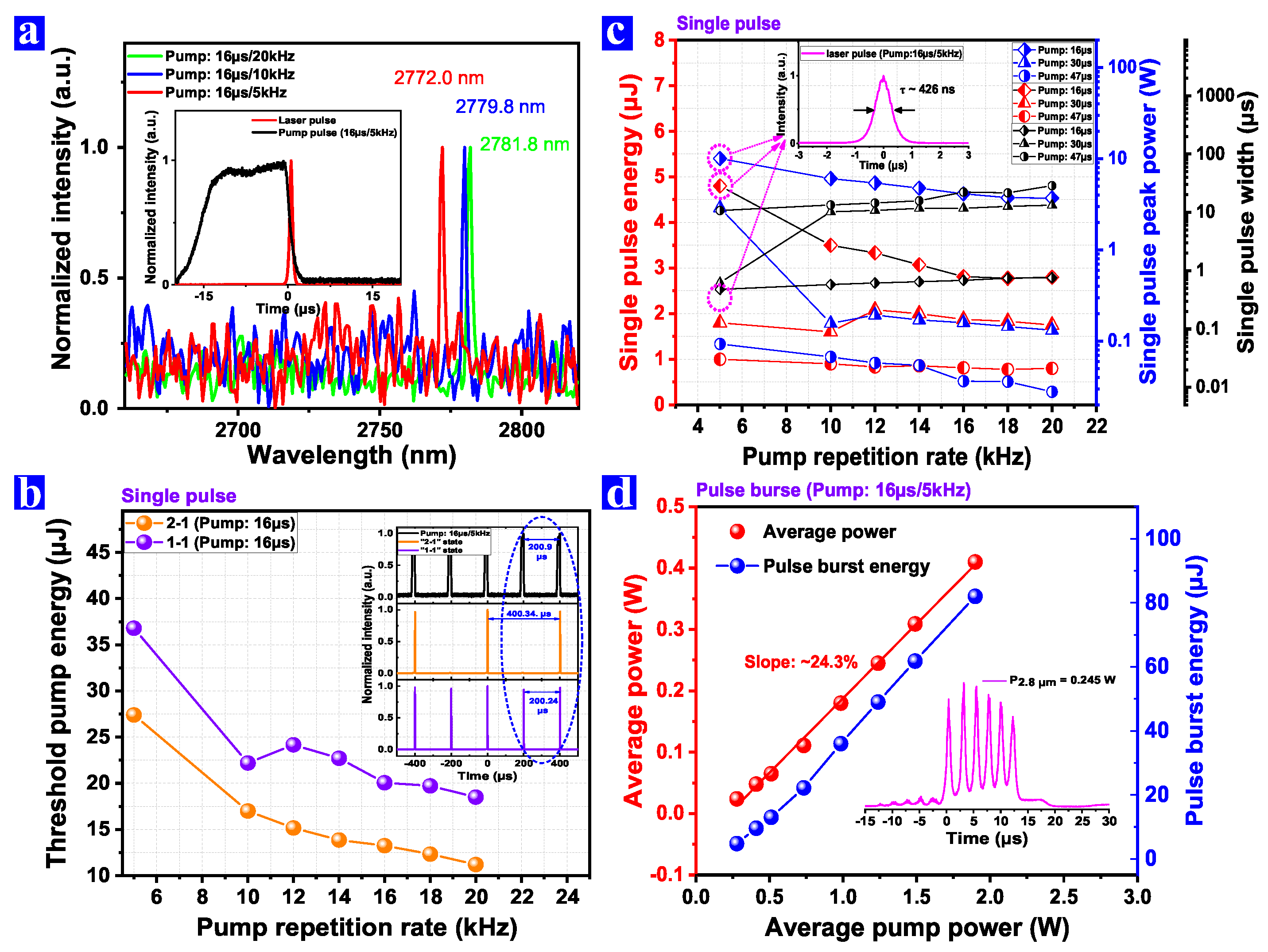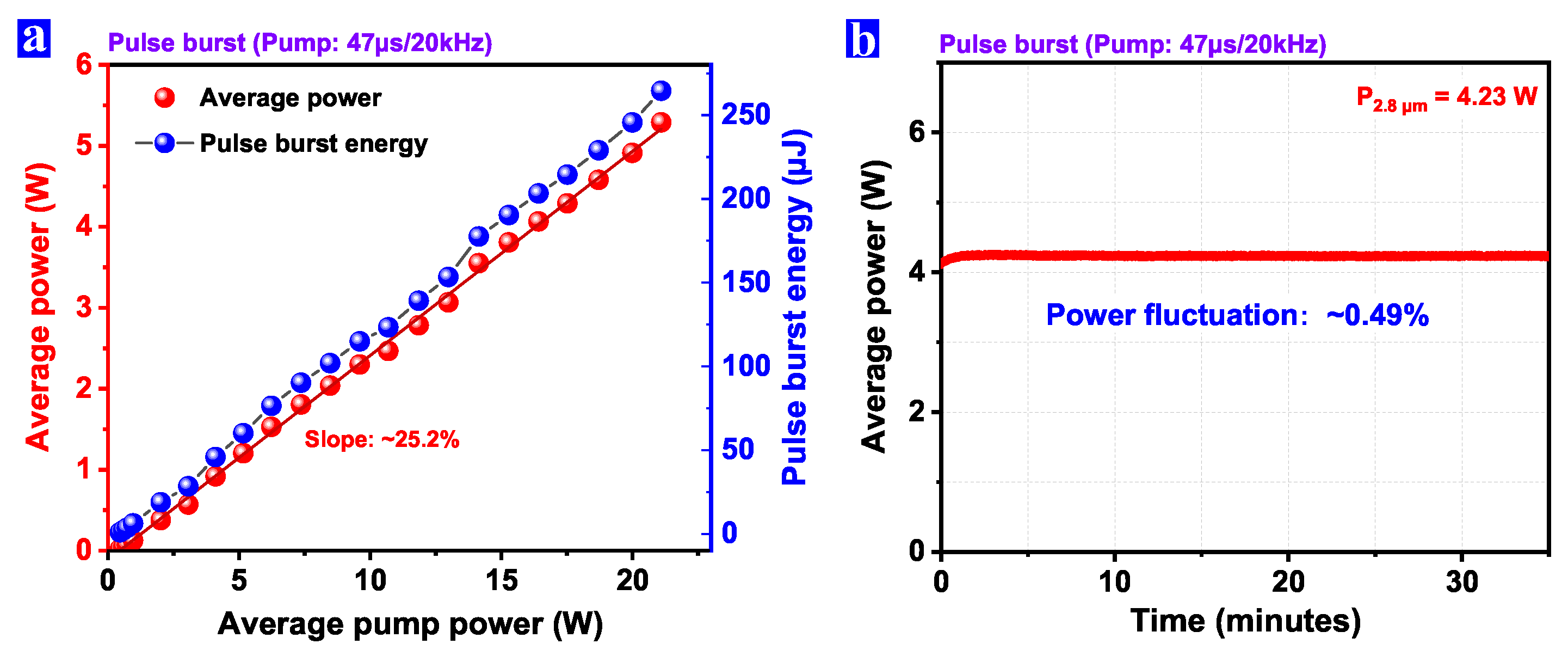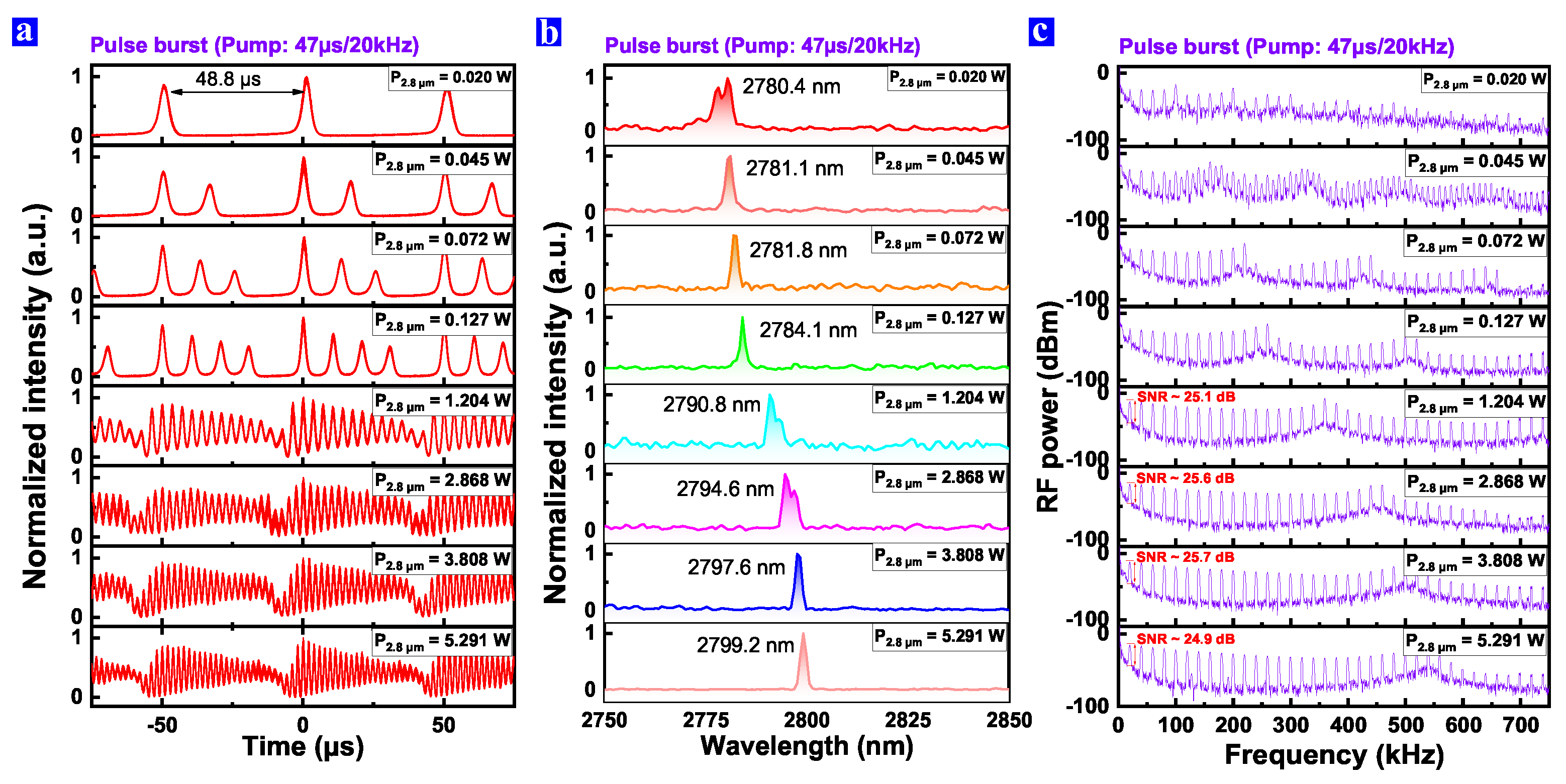5.3 W/265 μJ Mid-IR All-Fiber Er3+:ZBLAN Gain-Switched Laser Based on Dielectric Fiber Mirror and Fiber-Tip Protection
Abstract
:1. Introduction
2. Experimental Setup
3. Results and Discussion
4. Conclusions
Author Contributions
Funding
Institutional Review Board Statement
Informed Consent Statement
Data Availability Statement
Conflicts of Interest
Abbreviations
| MIR | mid-infrared |
| AR | anti-reflection |
| FPM | fiber pigtail mirror |
| LD | laser diode |
| DC | double cladding |
| SNR | signal-to-noise ratio |
Appendix A
| Year | Institution | Wavelength | Gain Fiber | Structure | Power/Energy | Efficiency |
|---|---|---|---|---|---|---|
| 2001 [22] | UoM | 2.7 μm | Er3+:ZBLAN | Free space | 1.9 mJ | 13.5% |
| 2011 [23] | Uni. of Ljubljana | 2.8 μm | Er3+:ZBLAN | Free space | 2 W | 34% |
| 2017 [25] | UESTC | 2.699–2.869 μm | Er3+:ZBLAN | Free space | 473.3 mW | - |
| 2018 [24] | Université Laval | 2.826 μm | Er3+:ZBLAN | All fiber | 11.20 W/80 μJ | 28% |
| 2018 [26] | Université Laval | 3.55 μm | Er3+:ZBLAN | Free space | 180 μJ | 4.7% |
| 2018 [27] | UESTC | 3.46 μm | Er3+:ZBLAN | Free space | 1.04 W/10.4 μJ | 24.6% |
| 2018 [28] | Macquarie Uni. | 2.8–3.4 μm | Dy3+:ZBLAN | Free space | 170 mW | 21% |
| 2018 [31] | UESTC | 2.895–3.0 μm | Ho3+:ZBLAN | Free space | 389.3 mW/4.87 μJ | 10.8% |
| 2019 [29] | UESTC | 2.8–3.1 μm | Dy3+:ZBLAN | Free space | 218.6 mW/2.73 μJ | 9.4% |
| 2020 [30] | Université Laval | 3.24 μm | Dy3+:ZBLAN | Free space | 1.43 W/19.2 μJ | 22% |
| 2020 [32] | Xiamen uni. | 2.92 μm | Ho3+:ZBLAN | All fiber | 54.2 mW | 10.12% |
References
- Yumoto, M.; Saito, N.; Lin, T.; Kawamura, R.; Aoki, A.; Izumi, Y.; Wada, S. High-energy, nanosecond pulsed Cr: CdSe laser with a 2.25–3.08 μm tuning range for laser biomaterial processing. Biomed. Opt. Express 2018, 9, 5645–5653. [Google Scholar] [CrossRef] [PubMed]
- Garcia-Lechuga, M.; Casquero, N.; Wang, A.; Grojo, D.; Siegel, J. Deep silicon smorphization induced by femtosecond laser pulses up to the mid-infrared. Adv. Opt. Mater. 2021, 9, 2100400. [Google Scholar] [CrossRef]
- Kerse, C.; Kalaycıoğlu, H.; Elahi, P.; Çetin, B.; Kesim, D.K.; Akçaalan, Ö.; Yavaş, S.; Aşık, M.D.; Öktem, B.; Hoogland, H.; et al. Ablation-cooled material removal with ultrafast bursts of pulses. Nature 2016, 537, 84–88. [Google Scholar] [CrossRef] [PubMed]
- Caballero-Lucas, F.; Obata, K.; Sugioka, K. Enhanced ablation efficiency for silicon by femtosecond laser microprocessing with GHz bursts in MHz bursts (BiBurst). Int. J. Extrem. Manuf. 2022, 4, 015103. [Google Scholar] [CrossRef]
- Lambert-Girard, S.; Allard, M.; Piché, M.; Babin, F. Differential optical absorption spectroscopy lidar for mid-infrared gaseous measurements. Appl. Opt. 2015, 54, 1647–1656. [Google Scholar] [CrossRef]
- Refaat, T.F.; Singh, U.N.; Petros, M.; Remus, R.; Yu, J. Self-calibration and laser energy monitor validations for a double-pulsed 2-μm CO2 integrated path differential absorption lidar application. Appl. Opt. 2015, 54, 7240–7251. [Google Scholar] [CrossRef] [PubMed]
- Li, X.; Luo, P. Boosting ranging performance of LiDAR using multi-pulse coherent average. IEEE Sens. J. 2019, 15, 6270–6278. [Google Scholar] [CrossRef]
- Holcomb, J.D. Versatility of erbium YAG laser: From fractional skin rejuvenation to full-field skin resurfacing. Facial Plast. Surg. Clin. 2011, 19, 261–273. [Google Scholar] [CrossRef] [PubMed]
- Stübinger, S. Advances in bone surgery: The Er: YAG laser in oral surgery and implant dentistry. Clin. Cosmet. Inv. Dent. 2010, 2, 47–62. [Google Scholar] [CrossRef]
- Pratisto, H.; Frenz, M.; Ith, M.; Altermatt, H.J.; Jansen, E.D.; Weber, H.P. Combination of fiber-guided pulsed erbium and holmium laser radiation for tissue ablation under water. Appl. Opt. 1996, 35, 3328–3337. [Google Scholar] [CrossRef]
- Bekman, H.T.; Van Den Heuvel, J.C.; Van Putten, F.J.M.; Schleijpen, R. Development of a mid-infrared laser for study of infrared countermeasures techniques. In Proceedings of the European Symposium on Optics and Photonics for Defence and Security, London, UK, 29 December 2004; Technologies for Optical Countermeasures. pp. 27–38. [Google Scholar]
- Wang, X.; Hu, Q.; Wang, Y. Study of mid-infrared laser jamming effect on reticle-based seekers. In Proceedings of the Seventeenth National Conference on Laser Technology and Optoelectronics, Shanghai, China, 23–26 August 2022; pp. 380–383. [Google Scholar]
- Coleman, D.J.; King, T.A.; Ko, D.-K.; Lee, J. Q-switched operation of a 2.7 μm cladding-pumped Er3+/Pr3+ codoped ZBLAN fibre laser. Opt. Commun. 2004, 236, 379–385. [Google Scholar] [CrossRef]
- Hu, T.; Hudson, D.D.; Jackson, S.D. Actively Q-switched 2.9 μm Ho3+Pr3+-doped fluoride fiber laser. Opt. Lett. 2012, 37, 2145–2147. [Google Scholar] [CrossRef] [PubMed]
- Tokita, S.; Murakami, M.; Shimizu, S.; Hashida, M.; Sakabe, S. 12 W Q-switched Er: ZBLAN fiber laser at 2.8 μm. Opt. Lett. 2011, 36, 2812–2814. [Google Scholar] [CrossRef] [PubMed]
- Li, J.; Hu, T.; Jackson, S.D. Dual wavelength Q-switched cascade laser. Opt. Lett. 2012, 37, 2208–2210. [Google Scholar] [CrossRef] [PubMed]
- Woodward, R.I.; Majewski, M.R.; Macadam, N.; Hu, G.; Albrow-Owen, T.; Hasan, T. and Jackson, Stuart D. Q-switched Dy:ZBLAN fiber lasers beyond 3 μm comparison of pulse generation using acousto-optic modulation and inkjet-printed black phosphorus. Opt. Express 2019, 27, 15032–15045. [Google Scholar] [CrossRef] [PubMed]
- Lü, Y.; Wei, C.; Zhang, H.; Kang, Z.; Qin, G.; Liu, Y. Wideband tunable passively Q-switched fiber laser at 2.8 μm using a broadband carbon nanotube saturable absorber. Photonics Res. 2019, 7, 14–18. [Google Scholar] [CrossRef]
- Qin, Z.; Xie, G.; Zhang, H.; Zhao, C.; Yuan, P.; Wen, S.; Qian, L. Black phosphorus as saturable absorber for the Q-switched Er: ZBLAN fiber laser at 2.8 μm. Opt. Express 2015, 23, 24713–24718. [Google Scholar] [CrossRef] [PubMed]
- Kang, Z.; Liu, M.; Li, Z.; Li, S.; Jia, Z.; Liu, C.; Qin, W.; Qin, G. Passively Q-switched erbium doped fiber laser using a gold nanostars based saturable absorber. Photonics Res. 2018, 6, 549–553. [Google Scholar] [CrossRef]
- Wei, C.; Zhu, X.; Norwood, R.A.; Peyghambarian, N. Passively Q-switched 2.8-μm nanosecond fiber laser. IEEE Photonics Technol. Lett. 2012, 24, 1741–1744. [Google Scholar] [CrossRef]
- Dickinson, B.C.; Golding, P.S.; Pollnau, M.; King, T.A.; Jackson, S.D. Investigation of a 791-nm pulsed-pumped 2.7-μm Er-doped ZBLAN fibre laser. Opt. Commun. 2001, 191, 315–321. [Google Scholar] [CrossRef]
- Gorjan, M.; Marinček, M.; Čopič, M. High-power pulsed diode-pumped Er: ZBLAN fiber laser. Opt. Lett. 2011, 36, 1923–1925. [Google Scholar] [CrossRef] [PubMed]
- Paradis, P.; Fortin, V.; Aydin, Y.O.; Vallée, R.; Bernier, M. High-power pulsed diode-pumped Er: ZBLAN fiber laser. Opt. Lett. 2018, 43, 3196–3199. [Google Scholar] [CrossRef] [PubMed]
- Wei, C.; Luo, H.; Shi, H.; Lyu, Y.; Zhang, H.; Liu, Y. Widely wavelength tunable gain-switched Er3+-doped ZBLAN fiber laser around 2.8 μm. Opt. Express 2017, 25, 8816–8827. [Google Scholar] [CrossRef] [PubMed]
- Jobin, F.; Fortin, V.; Maes, F.; Bernier, M.; Vallée, R. Gain-switched fiber laser at 3.55 μm. Opt. Lett. 2018, 43, 1770–1773. [Google Scholar] [CrossRef]
- Luo, H.; Yang, J.; Liu, F.; Hu, Z.; Xu, Y.; Yan, F.; Peng, H.; Ouellette, F.; Li, J.; Liu, Y. Watt-level gain-switched fiber laser at 3.46 μm. Opt. Express 2018, 27, 1367–1375. [Google Scholar] [CrossRef] [PubMed]
- Majewski, M.R.; Woodward, R.I.; Jackson, S.D. Dysprosium-doped ZBLAN fiber laser tunable from 2.8 μm to 3.4 μm, pumped at 1.7 μm. Opt. Lett. 2018, 43, 971–974. [Google Scholar] [CrossRef]
- Luo, H.; Xu, Y.; Li, J.; Liu, Y. Gain-switched dysprosium fiber laser tunable from 2.8 to 3.1 μm. Opt. Express 2019, 27, 27151–27158. [Google Scholar] [CrossRef] [PubMed]
- Jobin, F.; Paradis, P.; Fortin, V.; Magnan-Saucier, S.; Bernier, M.; Vallée, R. 1.4 W in-band pumped Dy3+-doped gain-switched fiber laser at 3.24 μm. Opt. Lett. 2020, 45, 5028–5031. [Google Scholar] [CrossRef]
- Luo, H.; Li, J.; Hai, Y.; Lai, X.; Liu, Y. State-switchable and wavelength-tunable gain-switched mid-infrared fiber laser in the wavelength region around 2.94 μm. Opt. Express 2018, 26, 63–79. [Google Scholar] [CrossRef]
- Zhang, X.; Li, W.; Li, J.; Xu, H.; Cai, Z.; Luo, Z. Mid-infrared all-fiber gain-switched pulsed laser at 3 μm. Opto-Electron. Adv. 2020, 3, 190032. [Google Scholar] [CrossRef]
- Caron, N.; Bernier, M.; Faucher, D.; Vallée, R. Understanding the fiber tip thermal runaway present in 3 μm fluoride glass fiber lasers. Opt. Express 2012, 20, 22188–22194. [Google Scholar] [CrossRef]
- Pushkin, A.V.; Migal, E.A.; Uehara, H.; Goya, K.; Tokita, S.; Frolov, M.P.; Korostelin, Y.V.; Kozlovsky, V.I.; Skasyrsky, Y.K.; Potemkin, F.V. Compact, highly efficient, 2.1-W continuous-wave mid-infrared Fe: ZnSe coherent source, pumped by an Er: ZBLAN fiber laser. Opt. Lett. 2012, 43, 5941–5944. [Google Scholar] [CrossRef] [PubMed]
- Rayner, A.; Hirsch, M.; Heckenberg, N.R.; Rubinsztein-Dunlop, H. Distributed laser refrigeration. Appl. Opt. 2001, 40, 5423–5429. [Google Scholar] [CrossRef] [PubMed]
- Le Flohic, M.; Franchois, P.-L.; Allain, J.-Y.; Sanchez, F.; Stephan, G.M. Dynamics of the transient buildup of emission in Nd3+-doped fiber lasers. IEEE J. Quantum Electron. 1991, 27, 1910–1921. [Google Scholar] [CrossRef]








Disclaimer/Publisher’s Note: The statements, opinions and data contained in all publications are solely those of the individual author(s) and contributor(s) and not of MDPI and/or the editor(s). MDPI and/or the editor(s) disclaim responsibility for any injury to people or property resulting from any ideas, methods, instructions or products referred to in the content. |
© 2024 by the authors. Licensee MDPI, Basel, Switzerland. This article is an open access article distributed under the terms and conditions of the Creative Commons Attribution (CC BY) license (https://creativecommons.org/licenses/by/4.0/).
Share and Cite
Chen, T.; Su, J.; Zhong, W.; Ding, Y.; Huang, L.; Bu, Y.; Li, J.; Luo, Z. 5.3 W/265 μJ Mid-IR All-Fiber Er3+:ZBLAN Gain-Switched Laser Based on Dielectric Fiber Mirror and Fiber-Tip Protection. Photonics 2024, 11, 700. https://doi.org/10.3390/photonics11080700
Chen T, Su J, Zhong W, Ding Y, Huang L, Bu Y, Li J, Luo Z. 5.3 W/265 μJ Mid-IR All-Fiber Er3+:ZBLAN Gain-Switched Laser Based on Dielectric Fiber Mirror and Fiber-Tip Protection. Photonics. 2024; 11(8):700. https://doi.org/10.3390/photonics11080700
Chicago/Turabian StyleChen, Tingting, Jue Su, Wenbo Zhong, Yu Ding, Lu Huang, Yikun Bu, Jianfeng Li, and Zhengqian Luo. 2024. "5.3 W/265 μJ Mid-IR All-Fiber Er3+:ZBLAN Gain-Switched Laser Based on Dielectric Fiber Mirror and Fiber-Tip Protection" Photonics 11, no. 8: 700. https://doi.org/10.3390/photonics11080700






